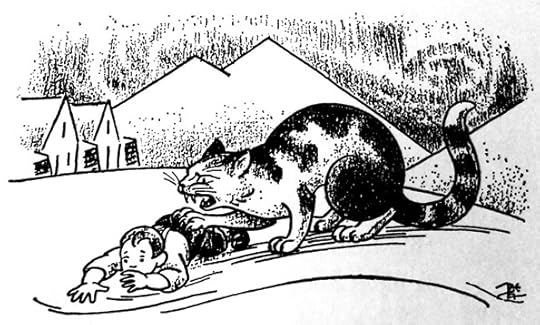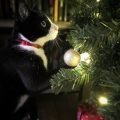The Legend of the Yule Cat
The legend of the Yule Cat is a Christmas story that is celebrated and told to Icelandic children even today. Every year a large Christmas cat is erected in the Laekjartorg square in Reykjavik.

Based on Icelandic folklore, the poem, The Christmas Cat, written by the poet Jóhannes úr Kötlum (1899-1972), describes a gigantic and very dangerous cat that prowls the snowy countryside and catches people instead of mice during Christmas.

You know the Christmas cat
– that cat is very large.
We don’t know where he came from
nor where he has gone.
He opened his eyes widely
glowing both of them.
It was not for cowards
to look into them.
His hair sharp as needles
his back was high and bulgy and claws on his hairy paw
were not a pretty sight.
Therefore the women competed
to rock and sow and spin
and knitted colorful clothes
or one little sock.
For the cat could not come
and get the little children.
They had to get new clothes
from the grownups.
When Christmas eve was lighted
and the cat looked inside
the children stood straight and red-cheeked
with their presents.
He waved his strong tail,
he jumped, scratched and blew
and was either in the valley
or out on the headland.
He walked about, hungry and mean
in hurtfully cold Christmas snow
and kindled the hearts with fear
in every town.
If outside one heard a weak “meow”
then unluck was sure to happen.
All knew he hunted men
and didn’t want mice.
He followed the poorer people
who didn’t get any new clothing
near Christmas – and tried and lived
in poorest conditions.
From them he took at the same time
all their Christmas food
and ate them also if he could.
Therefore the women competed
to rock and sow and spin
and knitted colorful clothes
or one little sock.
Some had gotten an apron
and some had got a new shoe
or anything that was needful.
But that was enough
For pussy should not eat no-one
who got some new piece of clothes.
He hissed with his ugly voice
and ran away.
If he still exists, I don’t know.
But for nothing would be his trip
if everybody would get next Christmas
some new rag.
You may want to keep it in mind
to help if there is need.
For somewhere there might be children
who get nothing at all.
Perhaps that looking for those who suffer
from lack of plentiful lights
will give you a happy season
and Merry Christmas.

The Yule Cat story or as it is titled in Icelandic, Jólakötturinn, is said to have originated during the Dark Ages even though the oldest written versions of the story are from the 19th century. The story relates how Medieval employers would reward their employees for their hard work with new clothes and shoes every Christmas. However, if you were lazy and were not rewarded with new clothes, the Yule Cat would come and eat you. A new twist to the story is if you give new clothes to someone, you will not be eaten. The story is obviously meant for children to encourage them to be productive and avoid laziness.
The Netflix film, The Christmas Chronicles 2 features the Yule Cat.
Want to know more about the cat in literature, art and history? Then Revered and Reviled is the book for you. Now available on Amazon in both paperback and Kindle formats.
(function(d, s, id) {
var js, fjs = d.getElementsByTagName(s)[0];
if (d.getElementById(id)) return;
js = d.createElement(s); js.id = id;
js.src = "//forms.aweber.com/form/19/57628519.js&...
fjs.parentNode.insertBefore(js, fjs);
}(document, "script", "aweber-wjs-6vneq2vrs"));
The post The Legend of the Yule Cat appeared first on THE GREAT CAT.
Related posts:
 Cat Superstitions by Country
Cat Superstitions by Country The Christmas Cat, The Cat Who Loved Christmas
The Christmas Cat, The Cat Who Loved Christmas How the Willows Came to be Called Pussy Willows
How the Willows Came to be Called Pussy Willows




